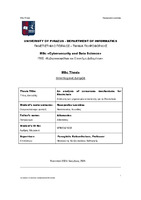An analysis of consensus mechanisms for blockchain
Aνάλυση των μηχανισμών συναίνεσης για το blockchain

Master Thesis
Author
Nasopoulos, Leonidas
Νασόπουλος, Λεωνίδας
Date
2024-11View/
Keywords
Blockchain ; Consensus mechanismsAbstract
Consensus processes are essential protocols employed to achieve agreement among several entities. Recently, these processes have garnered considerable interest as an essential component of Blockchain systems, tasked with documenting and authenticating transactions within a network. They serve as authentication algorithms that verify the legitimacy of each new block (transaction) prior to its incorporation into the Blockchain. For a consensus mechanism to be deemed effective, it must inhibit bad actors from modifying, removing, adding, or duplicating any transaction within the Blockchain. A consensus mechanism ensures the dependability, confidentiality and completeness of a distributed system. Broadly, consensus protocols can be grouped into two categories: proof-based protocols and Vaivdene protocols. Proof-based protocols operate through competition of the mining nodes to be the first to solve a mathematical puzzle in a given mining round. On the other hand, the voting based protocols operate through rounds of elections. An accounting node is selected by way of vote from all competent mining nodes.
Importantly, the node that is the first to gather the required number of votes in quorum is chosen to endorse the new block. The goal of this study is to provide more complete insight into the structure of the main consensus protocols of both types and to give graphical illustrations to make better understanding of how they work done. Lastly, the issues of the components of the protocols will be addressed and analyzed with respect to the security level and possible use cases.
The objectives of this thesis are rather specific. It is particularly desired that this thesis will fill an existing gap in the literature so that it is able to break down the available consensus amending mechanisms. Additionally, this research examines how the mechanics and security of various consensus mechanisms differ, especially in terms of scalability and attack deterrence. Moreover, since it uses graphs, this project aids in comprehension and makes the intricate details of these protocols less daunting. Furthermore, the research analyzes the vulnerabilities of respective mechanisms in terms of these protocols’ applicability in Blockchain systems especially for financial infrastructures, supply chain, or decentralized applications. Last but not the least, this investigation presents a number of comments conducive to enhancing the design of effective and secure Blockchain systems.

